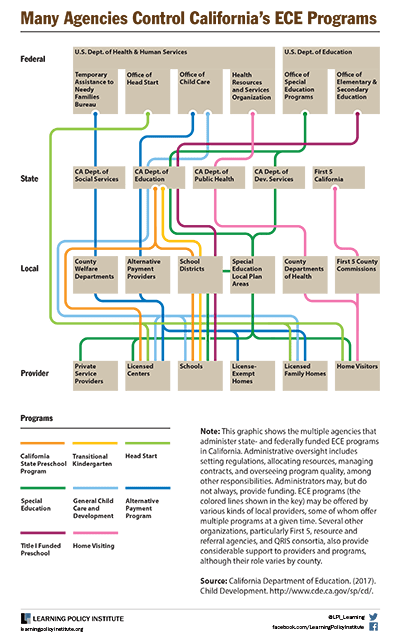PALO ALTO, CA—California is home to more than 3 million children from birth through age 5. These children are in a critical phase of development that will, in part, determine their long-term academic success, health, and well-being. And, while research shows that participation in high-quality early care and education programs (ECE) can have a highly positive impact on children’s development, many of California’s children don’t have access to that care.
A Blue Ribbon Commission has just been launched by the state legislature to take up these problems and a forthcoming report by the Learning Policy Institute lays out the key problems that need to be solved. Understanding California’s Early Care and Education System finds that access to high-quality ECE is a challenge because — in addition to budget cuts — the state’s ECE system has been constructed incrementally, has complex and fragmented funding and administration systems, and has a range of inconsistent requirements and services, creating a patchwork of programs that lack the coherence and capacity to serve all the state’s children effectively (see figure).
This lack of access is especially concerning for California’s 1.3 million children from birth to age five who live in or near poverty and dual language learners, who make up a third of the state’s incoming kindergarteners. High-quality, publicly funded ECE programs are important in supporting these young learners, giving them a strong start on the path that leads to college or career, fostering meaningful advantages in school readiness, and providing long-term benefits such as lower rates of special education placement and higher graduation rates.
Understanding California’s Early Care and Education System first looks at the current landscape of ECE in California and details the state’s various programs and funding sources, as well as levels of access and quality. It finds that there are several policy areas that must be addressed in order to achieve a coherent, equitable system. Specifically:
- Funding flows from an amalgam of federal, state, and local funding sources that make funds difficult to administer, as well as vulnerable to economic fluctuations.
- There is a substantial unmet need for publicly funded ECE programs, including programs for infants and toddlers and full-day programs, which are particularly limited in scope and have uneven access across the state.
- Differing regulations and standards create programs of varying quality across counties and sectors.
- A lack of consistent data makes it difficult for policymakers to make informed decisions.
The report also identifies five questions that state policymakers need to consider in order to create an ECE system that provides well-funded, high-quality care for all children:
- How can California move from a patchwork of disconnected programs to a more unified ECE system?
- How should California increase the availability of high-quality, full-day ECE programs that meet the needs of children and families?
- How can California more sustainably fund ECE programs?
- How can California continue to improve quality and supports for all ECE programs?
- How can California improve its data systems to inform strategic decision making?


